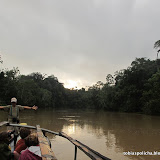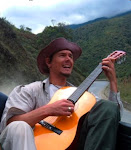So just wrapped up this teaching gig,
Has been quite an adventure,
Andes, amazon, islands.
Plants, birds, insects, mammals, reptiles, and amphibians!
From the relatively familiar forests of Mindo, to the monkey infested jungles of the amazon,
to watching Galapagos penguins fish in the surf along side sealions and pelicans!
A mix of teaching, learning and shepherding……
I have admittedly got quite behind in my travelogue-ing,
so some things will fall off
and this missive will largely focus on the field course portion of my adventure.
I have however posted some photos from my last trip to los cedros,
including some fairly researchy ones:
Things like orchid pollinia attached to the backs of fungi visiting flies
and insects that we were able to rear out of old flowers!

pollinia on a fungal visitor!
Evidence for two key aspects of this pollination system……
that these flies actually visit both organisms
and that some of them at least seem to be laying eggs as part of their reason for visiting!!!
Also spent about a week in Mindo.
Shooting for the second edition of my book……
I always see something new when I go out there!
Spent some time in my friend Hugolino’s orchid garden
which helped me move forward on some of my IDing!

Brassia sp
Came back to quito to give a talk at the Universidad Catolica on my research.
Kinda nervous about giving a talk in Spanish,
but as soon as I was up there, it all just kinda flowed!

Click here for a copy of the presentation!
Managed to catch some great music too!
Sergento Garcia, reggae, salsa, hip hop from france (but mostly in spanish),
a style he calls Salsa Muffin!
DJ Karim opened blending eastern European influences with latin rythms and dance beats!
cultural diversity mash up reminiscent of
the biodiversity mash up I have been suspended in….
worlds swirl and collide
musical traditions cross continents, oceans, and arrive again,
looping back through time and space…..
A good transition from fieldwork to teaching:
something totally different to cleanse the pallet.
BI 479
So this was a course from the UO,
mostly juniors and seniors in biology and environmental science.
The job description was somewhat long and convoluted
Teacher, guide, tour leader, organizer, comrade, colleague, student, porter, counselor….
This was not your run-of-the-mill graduate teaching position!
To top it off, of the faculty for the course, I had the best Spanish,
so lots of logistical stuff fell my way………
Working with other guides and scientists,
giving space for novelty, but providing a thread throughout……
Facilitating the students getting their minds blown,
but providing the framework to be able to put it all together in the end!
Culture, biology, ecology, conservation, economics, politics……
This place brings up all of these things.
Teaching plant families becomes the easy part,
when the need to impress the magnitude of the diversity,
the consequences of its lose
the role we all play,
and how the poverty we cannot avoid
is tied into the whole picture,
seems somehow more relevant.
At the same time seeing the intricate patterns and
beginning to pick apart the diversity
into manageable bites…..
(opposite leaves, prominent stipules – Rubiaceae – yay coffee!!!)
helps the immense wall of unfathomable green clarify,
overwhelmedness giving way to discerning observation.
A process that will serve them well in whatever they do
(and clearly not all of them will become field biologists!!!)

There were essentially three parts to the course
Two weeks in the andes
Comparing and contrasting both slopes (east and west)
A week in the amazon
The most diverse place on the planet!
And a week in the Galapagos
Mecca for evolutionary biologists, with its high rates of endemism and reproductive isolation!
ANDES
 |
| BI 479 Andes |
click photo to view the whole slideshow
The Andean portion started in Mindo.
I was glad to be in familiar territory
while vicariously recalling my own first impressions of the tropical cloud forest.
Focused on plant family recognition,
(Melastomataceae, Arecaceae, Orchidaceae…..)
insect orders,
(Coleoptera, orthoptera, diptera, hemiptera…)
we developed extensive bird lists:
including toucans, humming birds, motmots, trogans and more.
Flocks of parrots squawking overhead filled out the quintessential tropical bird experience!
After a brief stop in the high elevation paramo (moors) / Polylepis forest
(a rose family member with the distinction of being able to grow at higher elevations than any other tree in the world!)
we descended the eastern slopes of the andes to spend a few days at a research station called Yanayacu Biological Station & Center for Creative Studies.
Rudy Gelis was our guide here,
a lanky expat bird-whisperer.
Inca jays, tourqoise jays, mountain caciques, chestnut-breasted antpittas, and
Sickle-wing guans……..
Night monkeys on the night hike!!!
From here we descended further into the amazon basin to travel north to Baños
to spend a few days with Lou Jost,
orchid whiz, math geek, and bird book illustrator,
who recently ‘discovered’ the world’s smallest orchid!
He is very excited by a group of orchids (genus Teagueia)
That has undergone an adaptive radiation in the eastern andes,
With different species occupying different peaks in a relatively small geographical area.
A good example of the potential for diversity
facilitated by the riotous topography of this special place.
Informing not only conservation strategies but also the fundamental ways that we think about and measure biodiversity.

Teagueia
These tiny flowers only occur around and above 3000 m,
In places we thought would be too hard to access with the whole group of 18 students.
I spent my ‘day off’ in Baños with a friend,
Florian Werner, a german biologist who studies epiphyte communities in southern Ecuador, who had come to visit the class.
He was as (or maybe more) excited as I was to see these elusive flowers.
After five hours of slugging uphill through thick mud and crawling under dense thickets of bamboo we arrived in the cool stunted forest that houses these and innumerable other pleurothallid orchids.
Almost too tired and cold to even take a few pictures,
we relished the biogeographical implications of these flowers (smaller than my pinky nail),
and set off back down the mountain….
AMAZON
 |
| BI 479 Amazon |
click photo to view the whole slideshow
The next leg of the trip,
after a day in quito to do laundry
was to fully descend into the amazon basin,
which, heretofore we had only really caught glimpses of
The first thing,
besides the blanket of hot humidity and the verdant green of the landscape,
that always strikes me upon arrival into the amazon:
is how the rivers define the lifestyle.
People travel and settle the rivers in this land with very few roads.
And formidable rivers they are!
Even here, some 2000 miles from the atlantic coast (an elevation drop of a mere1000 ft!)
the channels are wide.
The first river we traveled was the Rio Napo.

One of 17 major Amazonian tributaries,
the Napo joins the main stem of the amazon just over the border in Iquitos, Peru.
(as a geological side note the amazon used to flow the other direction – east to west! Cut off and redirected by the relatively recent volcanism that created the andes mountains, a testament to the dynamic world will live in, where even the solid earth is malleable as clay!)
Constant traffic,
from dugout canoes
to barges carrying oil tankers.
About two hours downstream we stop.
From a boat landing we travel a couple hours by open walled bus
to the rio Tiputini,
which flows through Parque Nacional Yasuni
and is home to the Estacion Biodiversidad Tiputini.
Another three hours down the river,
and we arrive!!!
And what a place to be………
Pink dolphins in the river,
scores of insects provide a constant din,
birds of ridiculous color, and call:
macaws, more toucans, more parrots…..
Troupes of monkeys passing through the treetops:
Woolys
Spiders
Tamarinds
Squirrels
Howlers
and more!!!
Catching the sunset from the canopy tower,
the vast expanse of green laid out before me.
Passing rainstorm
replaced by mist rising off the treetops.
The very real feeing of being caught in the middle of a hydrological cycle of global import!

A reminder that this place is very much greater than the sum of its parts
(and it has more parts than anywhere else in the world!)
Remote and far away as it seems,
we all are dependent on the ‘ecosystem services’ provided by this region,
as a modulator of global climate.
And in a slightly more esoteric way, as a reserve for the genetic diversity that is the raw material of evolution!
These points are driven home as the sun goes down, revealing the glow of a natural gas plume in the distance……..
Yes under all of this lush diversity lies one of the biggest oil reserves in the world.
A glaring conflict of interests.
GALAPAGOS
 |
| BI 479 Galapagos |
click photo to view the whole slideshow
The ‘enchanted isles,’
they were called by the wailers and pirates
that first navigated the shifting currents around the
Galapagos islands.
In popular lore the Galapagos are inextricably linked to Darwn
as the inspiration for his unfolding theory of evolution.
While Darwin did spend some days here, as a young naturalist aboard the Beagle,
the real utilization of the archipelago as a ‘natural laboratory of evolution,’
fell to later scientists.
Most famously the Grant’s study of ‘Darwin’s’ finches
(a worthwhile and accessable account of which is given in “The Beak of the Finch” by Jonathan Weiner).

one of 'Darwin's' finches in a Scalesia tree
A host of factors have conspired through geological history to
establish a unique and interesting biota here.
A volcanic ‘hotspot’ located directly on the equator.
and at the intersection of several important oceanic currents.
Spewing magma established the current islands above sea level some 3 million years ago.
The nutrient dense, cold water brought from Antarctica by the Humbolt current provides ample resources to support a stupendous marine ecology, including scores of seabirds (including the charismatic boobies).

The confluence of the other currents contributing to sporadic colonization by continental cast-aways, followed by the reproductive isolation insured by the 1000 kilometers to the mainland.
A natural experiment in not only evolution, but also community assembly, adaptive radiation, and stress tolerance (in this land of rock and salt)!!!

Endemic prickly pears the size of trees.
Both a native and a weedy Passiflora.
The Tribulus (Zygophyllaceae), or ‘puncture vine,’ the famous famine food of
the finches studied by Rosemary and Peter Grant.
Marine iguanas that live off of algaes we would call seaweeds,
Sea turtles, giant tortoises, lava lizards.
At least four species of mangroves growing out of the lava in the intertidal zone!

As a botanical counterpart to Darwin’s finchs
The endemic genus of shrubby to tree-like Asters,
Scalesia has undergone an adaptive radiation here.
Some 16 species found nowhere else in the world!
Flamingos in the lagoon,
snorkeling with sharks,
all lend an air of otherworldliness……..

and then back to Quito!
Now preparing for my last weeks here,
which will include time at los cedros,
preparing all of our specimens for shipping,
a possible visit to Ecuagenera to collect Dracula fragrances,
and other odds and ends……
and then home!
After 5 months it is hard to imagine,
but travel always increases my appreciation for the little niche I occupy in Oregon.
Not because I enjoy the other places any less,
simply because my eyes are always opened to new and different things,
that reinform my experience of ‘home.’
Hasta pronto,
tobias





No hay comentarios:
Publicar un comentario